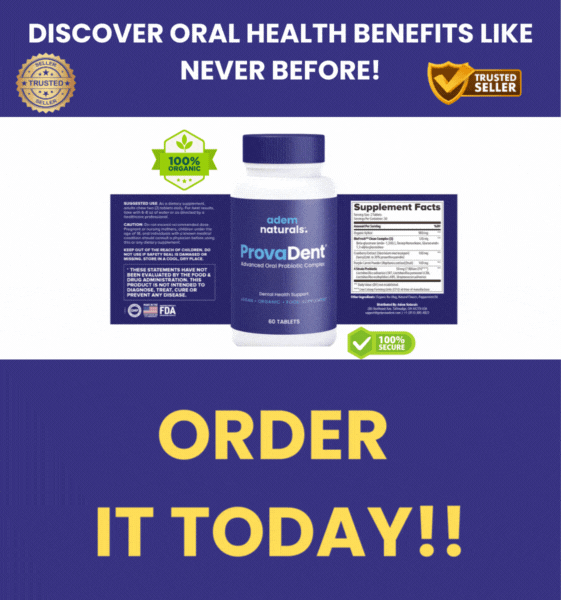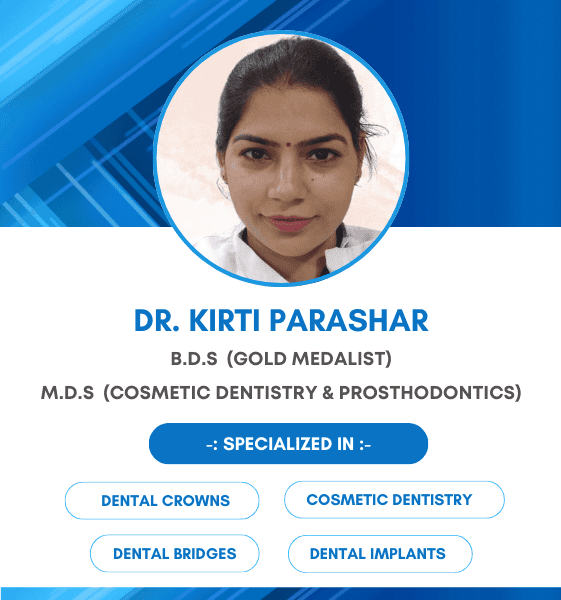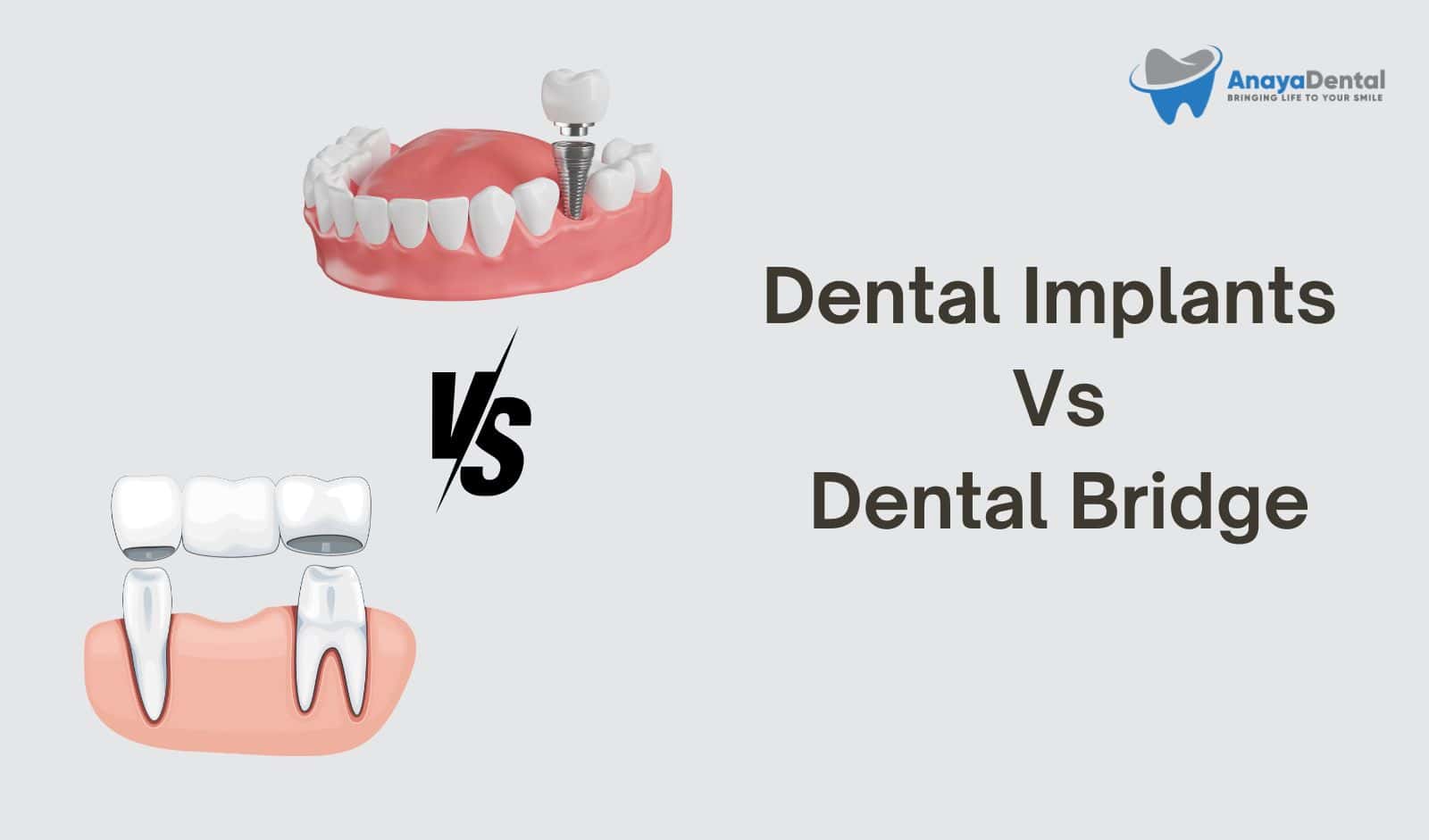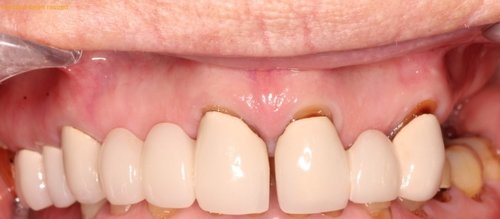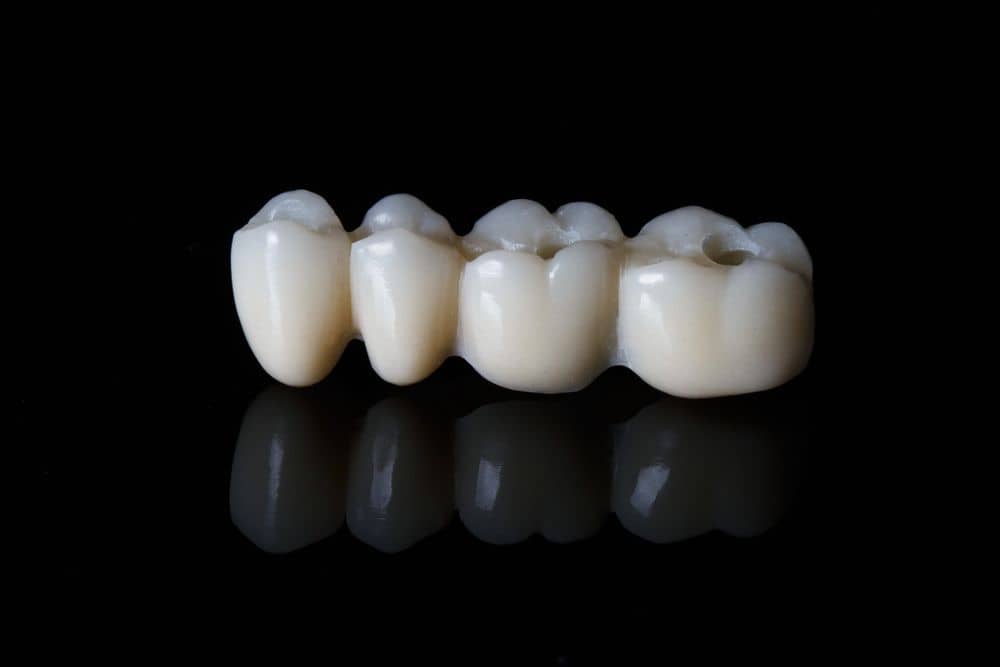How to Replace Front Teeth with a Dental Bridge involves understanding the process, benefits, and care needed for your dental health. This complete guide from AnayaDental covers everything you need to know about bridges, ensuring a smoother transition to a confident smile.
Understanding Dental Bridges for Front Teeth Replacement
What is a dental bridge?
A dental bridge helps replace missing teeth, especially in the front of your mouth. It’s a fixed dental prosthetic that consists of one or more fake teeth called pontics. These pontics are supported by abutment teeth on each side. The main goal of a dental bridge is to bring back your smile and help you chew properly.
Many people prefer dental bridges over removable options because they are more stable and look closer to real teeth. They can be made from different materials like ceramics, porcelain, or metal alloys. The best choice depends on what you need and like.
Try Our Dental Calculators
Why choose a bridge for front teeth restoration
Choosing a dental bridge for your front teeth has many benefits:
- Smile Restoration: A well-made bridge can make your smile look great again.
- Improved Functionality: It helps you chew food without any issues.
- Self-Confidence Boost: Having full front teeth makes you feel good in social settings.
Also, getting a dental bridge can help keep your face shape by stopping bone loss from missing teeth. This choice not only looks good but also helps with your overall oral health.

Types of dental bridges suitable for front teeth
There are various types of anterior dental bridges that are good for replacing front teeth:
- Ceramic Bridges: They match the color of your natural teeth well.
- Porcelain Bridges: These are strong and look very natural, making them perfect for visible areas.
- Zirconia Bridges: They are tough and still look nice; plus, they don’t wear down easily.
When thinking about these options, keep in mind factors that affect how they look. Things like matching the color to your existing teeth, designing the right shape to fit your face, and aligning with your bite matter a lot.
Talking with your dentist can help you choose the right type of bridge that suits you best while ensuring it works well and looks great!
Initial consultation and assessment
Before you get a dental bridge, you need to start with an initial consultation. During this dental examination, your dentist will check your oral health. This helps them see if you can have the procedure. They’ll look for any problems, like gum disease or tooth decay, that could affect treatment.
The dentist will talk about different dental services and how a dental bridge can assist with treatment for tooth loss. They will also answer your questions. This way, you’ll feel good about moving forward.
Preparing the adjacent teeth
After deciding to go ahead with a dental bridge, preparing the nearby teeth is very important. The teeth next to the gap are called abutment teeth. These will hold the bridge in place.
To prepare these teeth:
- The enamel might be removed from each abutment tooth to make room for crowns.
- Your dentist may suggest using dental crowns over these prepared teeth after shaping them.
- This falls under restorative dentistry and helps ensure that your new bridge fits well.
Getting the adjacent teeth ready is key to having a successful dental bridge.
Taking impressions for bridge fabrication
Next up, it’s time to make molds called dental impressions. These impressions act like blueprints for creating your fixed dental bridge.
During this step:
- A special material captures the shape of your gums and remaining natural teeth.
- The impression is used to make custom pontics (the fake tooth) that blend in with what you already have.
- Advanced dental procedures help ensure everything looks natural and works well when you chew.
Careful impression-taking plays a big role in making sure your new restoration is a success.
Temporary bridge placement
While you wait for your permanent bridge, a temporary one gets placed over the area. It does a few things:
- It protects your gums while you heal from enamel removal.
- It keeps your bite aligned until the final bridge arrives.
- Most temporary bridges look nice too; they help keep up appearances while healing happens.
Most people take about two weeks to recover before getting their permanent bridges.
Fitting and adjusting the permanent bridge
When it’s time, fitting and adjusting your permanent dental bridge is next.
During this visit:
- Your dentist checks how well it aligns with other teeth—this affects both looks and chewing function.
- Adjustments might be made based on how it feels; minor tweaks help make sure it fits just right before being secured.
- A good fit makes it last longer while letting you eat or talk without worries about discomfort or shifting.
Understanding each phase—from consultations through adjustments—helps you appreciate what goes into replacing missing front teeth effectively!
Materials and Aesthetics in Front Teeth Bridges
Popular materials for dental bridges
When choosing a dental bridge, there are several materials to think about. Each type has its own benefits that can change how it looks and works.
- Ceramic Bridges: These are very popular. They look like natural teeth and have a nice shine that mimics the translucency of enamel.
- Zirconia Bridges: These bridges are known for being super strong. They don’t chip easily, which is great for long-lasting use.
- Porcelain Bridges: Porcelain looks great but needs careful handling since it can break if not taken care of well.
- Composite Resin Bridges: These are a budget-friendly option. While they offer decent appearance, they might not last as long as the others.
- Dental Prosthetics Overview: Dental prosthetics include many tooth replacements like crowns and dentures. Bridges specifically help replace missing teeth effectively.
Picking the right material depends on your budget and how you want your smile to look!
Matching the color and appearance of natural teeth
A big part of getting a dental bridge is matching it to your real teeth. This helps create a seamless smile:
- Shade Matching: Dentists use special shade guides to find colors that look just like your natural teeth.
- Tooth Replacement Options: Different types of bridges let you customize colors better than others.
- Smile Restoration Techniques: Techniques now let dentists make lifelike artificial teeth by paying attention to details, like texture.
- Cosmetic Dentistry Innovations: Modern cosmetic dentistry aims for perfect harmony between new and old teeth.
Getting the color right helps boost self-confidence. When you feel good about your smile, you’re more likely to show it off!
Factors affecting the aesthetic outcome
Several factors play into how well a dental bridge fits with your smile:
- Overall Well-being: Good oral hygiene helps make sure dental work turns out well.
- Self-confidence Levels Post-Treatment: When colors match well, it can make people feel better when they’re around others.
- Bite Alignment Considerations: A good bite means comfort while eating; if it’s off, satisfaction may drop over time.
- Jaw Support Importance: Strong jaw support keeps replacements steady, helping them last longer during everyday use.
- Treatment Plans For Tooth Loss: Customized plans fit each patient’s needs perfectly, ensuring good results from start to finish.
By keeping these things in mind before choosing a front tooth replacement like a bridge, individuals can make smarter choices for better quality of life after treatment!
Cost Considerations and Insurance Coverage
Factors influencing the cost of front teeth bridges
The cost of a dental bridge can change based on a few key things. Knowing these can help you manage your dental treatment plan better. Here are some factors:
- Material Used: Different materials like porcelain, ceramic, and zirconia have various costs.
- Complexity of Treatment: If you need extra steps, like tooth removal or gum work, the cost will rise.
- Location: Dental offices in busy areas may charge more than those in quieter spots.
- Dentist’s Expertise: A highly skilled dentist might have higher fees but could deliver better results.
- Dental Treatment Plan: A good treatment plan that fits your needs can help with both care and cost.
By looking at these factors, you can find affordable dental care that works for you.
Average price range for different bridge types
Knowing the average price for different types of bridges helps when considering options in restorative dentistry. Here’s a quick look at what you might expect to pay:
| Bridge Type | Average Price Range |
|---|---|
| Fixed Dental Bridge | $1,500 – $5,000 |
| Ceramic Bridges | $2,000 – $4,500 |
| Zirconia Bridges | $2,500 – $6,000 |
| Porcelain Bridges | $1,800 – $5,200 |
These numbers are estimates; your actual cost may vary based on individual situations and the dentist’s fees.
Dental insurance coverage for bridges
Many dental insurance plans cover part of the costs for missing teeth solutions like bridges. Here’s what you should know about dental insurance coverage:
- Most plans cover between 50% to 80% of the procedure after deductibles are met.
- Look out for waiting periods—some plans make you wait before benefits kick in.
- Check your oral health benefits closely because they often state which materials or types are covered.
Understanding your insurance helps you get the most out of your benefits and control out-of-pocket expenses.
Financing options at AnayaDental
At AnayaDental, we get that finding affordable dental care is important when needing services like dental bridges. We offer various financing options to make quality care more accessible:
- Payment Plans: We have flexible payment choices so patients can spread out costs without high-interest fees.
- Third-party Financing Options: Partnering with financial institutions gives you extra choices tailored to healthcare expenses.
- Discount Programs: Some programs may provide discounts based on income or special promotions during the year.
These financing options aim to reduce financial stress while ensuring timely restorative treatments so you don’t have to wait long to get the care you need.
Caring for Your New Dental Bridge
Daily cleaning and maintenance tips
Caring for your dental bridge is key to keeping good dental hygiene and making sure your bridge lasts a long time. Here are some easy daily cleaning tips:
- Brush Twice a Day: Use a soft-bristled toothbrush with fluoride toothpaste. Make sure to brush around the bridge to remove plaque and food bits.
- Floss Daily: Flossing is super important. It gets to places that brushing might miss, especially around the crowns holding the bridge. You can use floss threaders or special interdental brushes for this.
- Use Antimicrobial Mouthwash: Rinsing with mouthwash can help cut down on bacteria in your mouth, which helps your overall oral health.
- Choose Soft Bristles: A toothbrush with soft bristles helps protect both your natural teeth and bridges.
- Inspect Your Bridge Regularly: Look for any signs of wear or damage each time you clean your teeth.
These habits can make a big difference in keeping up your oral health and ensuring that restorative dentistry solutions like bridges work well over time.
Foods to avoid with a dental bridge
Certain foods can harm both the function and look of your dental prosthetics like bridges. To protect what you’ve invested in tooth replacement options, it’s smart to avoid:
- Sticky Foods: Caramel or taffy can pull at the bridge, possibly loosening it.
- Hard Foods: Nuts, hard candies, or ice can crack parts of your dental prosthetic.
- Chewy Meats: Tough cuts may make chewing hard, which could put too much stress on the bridge.
- Acidic Foods & Drinks: Things like citrus fruits and soda can weaken the glue used for some restorations over time.
Being careful about what you eat helps keep chewing function good and keeps everything looking nice without worrying about damage.
Regular dental check-ups and professional cleanings
Going to regular dental check-ups is really important after getting a new dental bridge:
- Check Fit: Your dentist will see if the bridge fits properly.
- Professional Cleanings: These keep plaque from building up where brushing might not reach. This is really important for keeping gums healthy around restorations.
- Monitor Health: Regular visits help catch potential problems early before they become serious issues needing more treatment.
Sticking to this routine supports best practices in restorative dentistry while protecting against problems from neglecting professional care.
Signs that your bridge may need attention
It’s smart to know signs that mean something might be wrong with your dental bridge:
- Increased Sensitivity: If you feel more sensitivity near where the bridge sits, pay attention!
- Visible Damage: Cracks or chips around the edges could mean it needs repair right away.
- Gum Irritation: Redness or swelling near gums under support structures might mean an infection; seek advice if you see this!
- Unusual Movement: If you notice looseness when biting down—this needs quick checking!
Spotting these symptoms early means getting help quickly through proper treatments designed to fix issues linked back to restoring lost function effectively.
Alternatives to Dental Bridges for Front Teeth Replacement
Dental implants vs. bridges: Pros and cons
When you lose a tooth, you might think about dental implants or fixed dental bridges. Both are good options, but they come with different benefits and downsides.Dental Implants:
- Pros:
- They are a permanent fix that connects to your jawbone.
- Implants help keep your jaw strong and stop more tooth loss.
- They look and feel like real teeth.
- Cons:
- The cost can be high at first.
- Getting an implant needs surgery, which can take time to heal.
Fixed Dental Bridges:
- Pros:
- They usually cost less than implants.
- The process is faster since there’s no surgery involved.
- Cons:
- Bridges don’t stop bone loss in the jaw over time.
- You might need to change healthy teeth nearby.
In restorative dentistry, it’s smart to think about these points when choosing between dental implants and bridges. What works best for you depends on your oral health and personal needs.
Removable partial dentures as an option
If you’re looking for something different, removable partial dentures can be a good choice for missing front teeth. These dental prosthetics are great if you want something flexible or have several gaps.Benefits of Removable Partial Dentures:
- Affordable: Generally cheaper than implants or bridges.
- No Surgery Needed: Dentists can fit them quickly without any invasive procedures.
- Easily Changed: If your teeth shift or your gums change, they can adjust easily.
However, keep in mind that removable partial dentures might not feel as secure as bridges or implants.
When to consider other dental solutions
Sometimes it’s smart to explore other options besides the usual choices:
- Treatment for Tooth Loss: If you’ve lost many teeth from injury or decay, see a dentist about all your treatment choices.
- Overall Well-being: Bad oral health can hurt your overall health too. Acting fast helps prevent issues like gum disease from gaps in front teeth.
- Orthodontics Alternatives: If you have crooked teeth with gaps, braces or other treatments can improve both how your teeth look and work.
Thinking about these things will help you find the best way forward for your oral health while keeping your smile bright!
FAQs
Q1: What are the solutions for missing teeth?
A dental bridge is a popular solution. Other options include dental implants and removable partial dentures. Each has unique benefits.
Q2: How does dental anxiety affect the process?
Dental anxiety can make visits challenging. It’s essential to communicate fears with your dentist. They can provide options to help you feel more comfortable.
Q3: What is enamel removal, and why is it necessary?
Enamel removal prepares abutment teeth for crowns. This step ensures a proper fit for the dental bridge.
Q4: How do gaps in front teeth affect appearance?
Gaps can impact self-esteem and social interactions. A dental bridge effectively restores your smile.
Q5: Does dental insurance cover bridges?
Many plans cover a portion of the cost of dental bridges. Check your policy to understand coverage specifics.
Q6: What is the recovery time for a dental bridge?
Recovery time varies by individual, but most heal within two weeks. Follow your dentist’s aftercare instructions for best results.
Additional Considerations
- Dental Clinics: Look for a reputable clinic that specializes in restorative dentistry.
- Dental Treatment Plan: Your dentist will customize a plan based on your needs and goals.
- Healing Collar: This may be used post-surgery to support recovery.
- Implant Placement Timeline: If considering implants, ask about the timeline involved.
- Artificial Teeth: Dental bridges act as artificial teeth, improving both function and aesthetics.
- Aesthetics in Dentistry: Focus on materials that match natural teeth for optimal results.
- Benefits of Dental Bridges: These include improved function, restored smiles, and enhanced confidence.
- Speech Improvement: Replacing missing teeth can also improve speech clarity.
- Dental Emergencies: Contact your dentist immediately if any issues arise post-procedure.
- Advanced Dental Procedures: Ensure your clinic offers these for best outcomes in complex cases.

